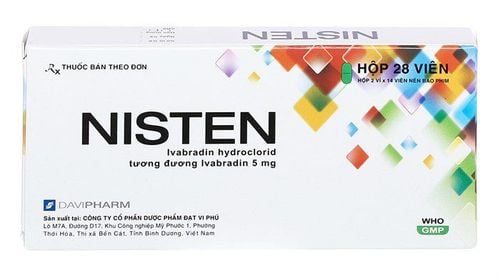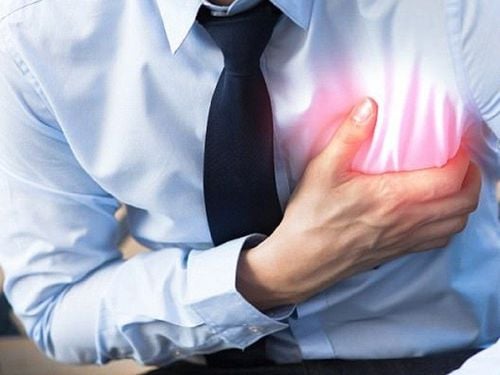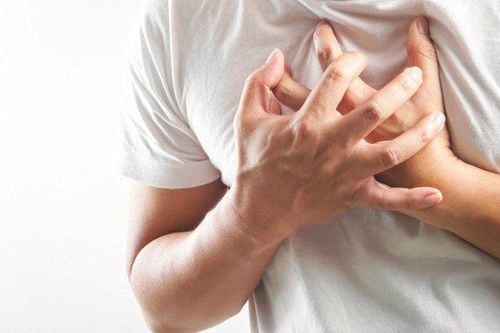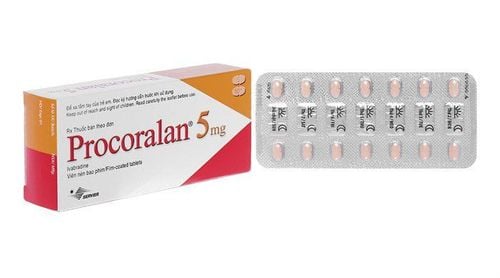This is an automatically translated article.
The article was professionally consulted by Specialist Doctor II, Senior Doctor Doan Du Dat - Department of Medical Examination and Internal Medicine - Vinmec Ha Long International General Hospital.Chest pain is a very common condition that affects everyone. Not only common in the elderly, chest pain also tends to gradually rejuvenate and come with many different signs such as: chest tightness, difficulty breathing, chest pain, nausea, angina on the left, right, in the chest. accompanied by a sharp pain in the heart.
1. Chest pain is a sign of what disease?
Chest pain can be a sign of many different medical conditions. If it is a transient chest pain, it is only a small symptom of common diseases such as indigestion. However, if chest tightness occurs continuously, related to exertion, repeated with increasing intensity, then it is more likely to be a sign of particularly dangerous diseases. Chest pain due to many causes, usually due to the following main causes:Chest pain due to cardiovascular disease. Chest pain due to pleurisy. Chest pain due to disease of the chest wall. In which, chest pain due to cardiovascular disease is the most life-threatening. Here are some common causes of chest pain.
Trắc nghiệm: Bạn có hiểu đúng về huyết áp cao không?
Huyết áp cao còn được gọi là kẻ giết người thầm lặng vì bệnh thường không có triệu chứng. Thiếu hụt kiến thức về huyết áp cao có thể làm cho tình trạng bệnh trở nên trầm trọng hơn. Dưới đây là những câu hỏi trắc nghiệm vui giúp bạn hiểu đúng về bệnh cao huyết áp.Most heart attacks occur when a blood vessel is suddenly blocked due to the obstruction of a thrombus, which stops blood flow. blood to the heart and cause permanent heart damage. At this time, the patient appeared to have severe, heavy left chest pain, the heart seemed to be strangled, accompanied by a feeling of fear and panic. Typically, chest pain from a heart attack can last for more than 15 minutes.
1.2. Aortic dissection The aorta is the largest and most important artery in the body, serving as a bridge to supply blood to the organs of the body. Aortic dissection is when the endothelium of the aorta is torn, allowing blood to seep in, causing ischemia and rupture of the aorta. Chest pain, dizziness, shortness of breath, and even fainting are signs of this phenomenon. This is an extremely dangerous case, adversely affecting life, causing acute heart failure and the risk of death is very high.
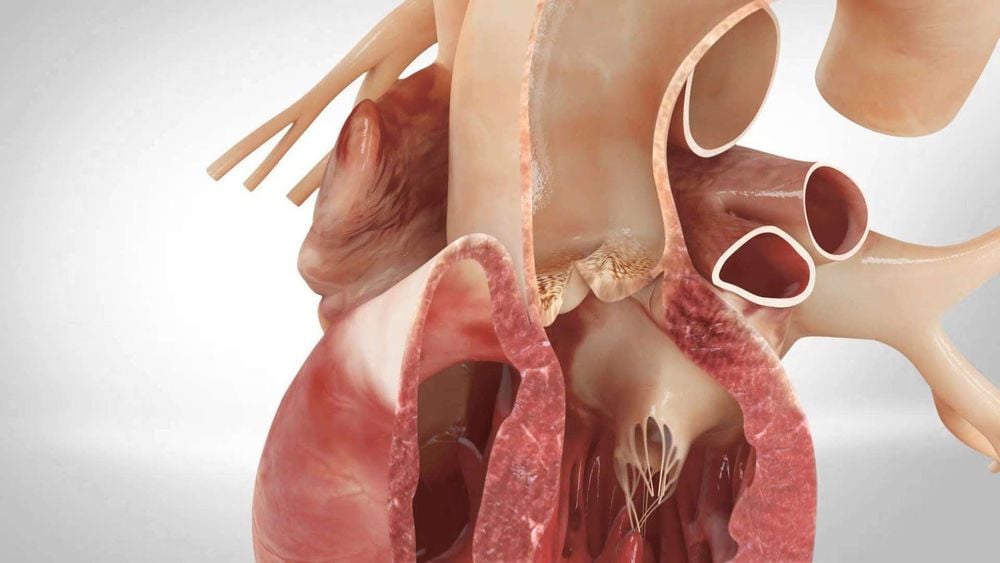
Lớp nội mạc động mạch chủ bị rách, gây nguy hiểm đến tính mạng.
1.3. Diseases of the lungs and pleura Such as pneumothorax (usually appearing suddenly and accompanied by shortness of breath), pleurisy, lung tumor,...
1.4. Chest trauma Injuries that occur in the chest area often cause patients to have dull left or right chest pain, due to localized soft tissue damage in the chest muscle, chest wall, or ribs,... Caused by chest trauma, every time the patient moves the body, moves the chest muscles or even takes a deep breath, it also causes chest pain. 1.5. Some diseases related to the intercostal nerve Chest pain is a manifestation of some diseases related to the intercostal nerves such as back disease.
1.6. Gastroesophageal reflux syndrome
2. Some Common Types of Chest Pain
2.1. Chest pain, difficulty breathing As mentioned above, chest pain and shortness of breath can be a sign of coronary heart disease. However, in most cases, chest pain and shortness of breath are caused by fairly common conditions such as gastroesophageal reflux or temporary narrowing of the airways.In addition, psychological factors are also the cause of chest tightness and shortness of breath, because prolonged anxiety, stress, and nervousness often affect breathing, making us short of breath, breathing irregularly, leading to shortness of breath. to lack of oxygen. The result is chest pain, shortness of breath and sharp pain in the chest area. Besides, "long-term" diseases, such as dyslipidemia, liver failure, kidney failure, diabetes are also the causes of chest pain and shortness of breath.
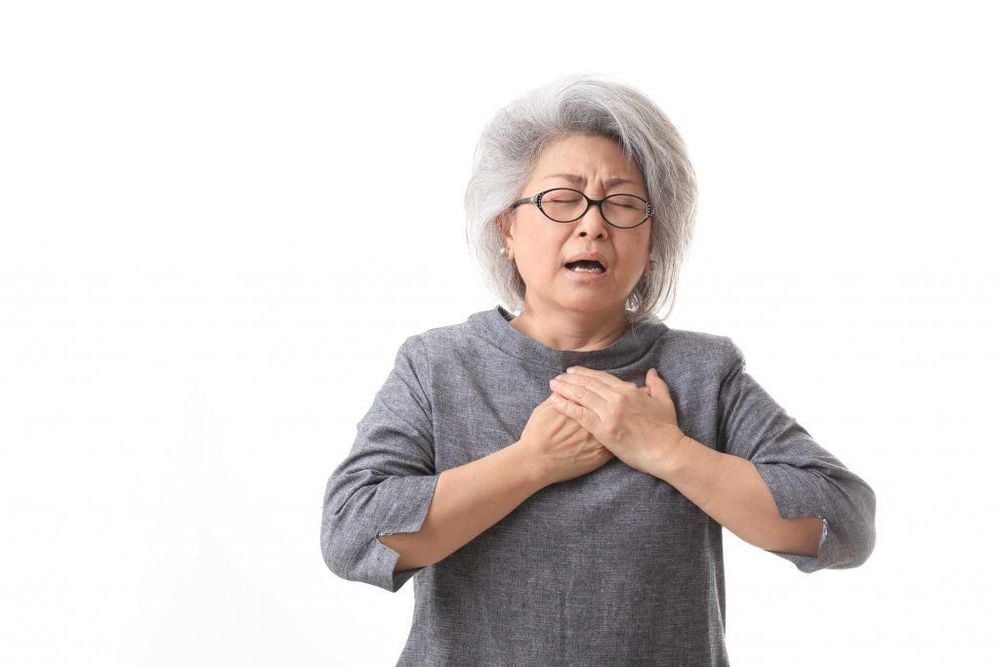
Đau tức ngực khó thở là biểu hiện của nhiều bệnh lý khác nhau.
2.2. Chest tightness, can't eat Indigestion is the cause of bloating, gas, bloating (or fullness of water), feeling like vomiting right after eating. This condition may be accompanied by dizziness, lightheadedness, heartburn, heartburn, discomfort, dullness in the stomach area, burning of the esophagus (the tube connecting the throat to the stomach, helping to bring food from the stomach). mouth going down to the stomach) and feel a pain in the chest in the middle.
With symptoms of bloating, chest tightness and indigestion, you should give priority to choosing foods that are good for the digestive system, such as yogurt, bananas, papaya. Besides, avoid fast foods, "experts" that cause bloating and indigestion such as fried foods with a lot of fat, carbonated drinks,...
2.3. Chest pain and nausea Nausea and chest pain is not a disease. Sometimes this is just a symptom of psychological problems, but in some cases, chest pain with nausea is warning you of the following relatively serious situations: :
Gastroesophageal reflux : Acid in the stomach back up into the esophagus, causing irritation to the nerve endings located in the esophageal epithelium, creating a sharp pain in the sternum. In addition, substances that are refluxed into the esophagus are not only gas and stomach acid, but also digested food, causing the patient to feel nausea and vomiting. Respiratory pathology: Symptoms of chest pain, nausea, difficulty breathing can also originate from a respiratory disorder or a respiratory infection. The affected respiratory system restricts the amount of oxygen entering the body, causing dizziness, angina, and nausea. Some respiratory disorders that can be the "culprit" of this condition are obstructive pulmonary disease, asthma, pulmonary edema,... Early stage of pregnancy: At this time, chest tightness and nausea may also be possible. called... morning sickness. Symptoms of morning sickness include: Nausea, chest tightness with fatigue, loss of appetite, difficulty eating, unusual appetite changes. This happens due to the sudden change in hormone levels in the body, causing a new pregnant woman to have a lot of physical and psychological changes, including symptoms: Chest pain and nausea.

Đau tức ngực và buồn nôn có thể là báo hiệu của một sinh linh bé nhỏ.
2.4. Chest pain and cough Cough is always an unpleasant thing for everyone, causing damage to the larynx, chest pain, and sharp pain in the chest area. Coughs and chest pain usually go away on their own in a few days or after taking medication. However, when chest pain occurs in the early morning, accompanied by a dry cough, a cough with phlegm that lasts for many weeks, and cough medicines, anti-inflammatory drugs do not work, then this may be Warning signs of lung cancer.
The cause of this malignancy is largely cigarette smoking. Because, when cigarette smoke is inhaled directly through the mouth, smokers have bypassed the first defense mechanism, the filtering process in the nose. From here, the smoke affects the structure of the mucous glands and changes the composition of the mucus. Furthermore, the glands that secrete mucus can become blocked, reducing the ability to excrete sputum. The consequence of this process is that the mucus is contaminated with a variety of toxic substances from cigarette smoke, and is retained in the lung tissues for many years, leading to lung cancer and the appearance of symptoms such as pain. chest and frequent cough.
Therefore, we need to be conscious in keeping the living environment green, clean, fresh air, not smoking or smoking completely. In addition, you should be treated for diseases related to bronchopulmonary (if any), such as bronchitis, tuberculosis,... Especially, for high-risk subjects (family history of the disease). cancer, the elderly, smoking, alcohol addiction,...), it is necessary to conduct regular check-ups and cancer screening for early detection and timely treatment.
2.5. Chest pain when eating and swallowing food Frequent chest pain accompanied by a feeling of choking when eating or swallowing food could be a sign of esophageal cancer. This is also a malignancy due to the appearance of tumors in the lumen of the esophagus. Patients often have no specific symptoms, or only pain when swallowing, difficulty swallowing, and chest pain when eating.
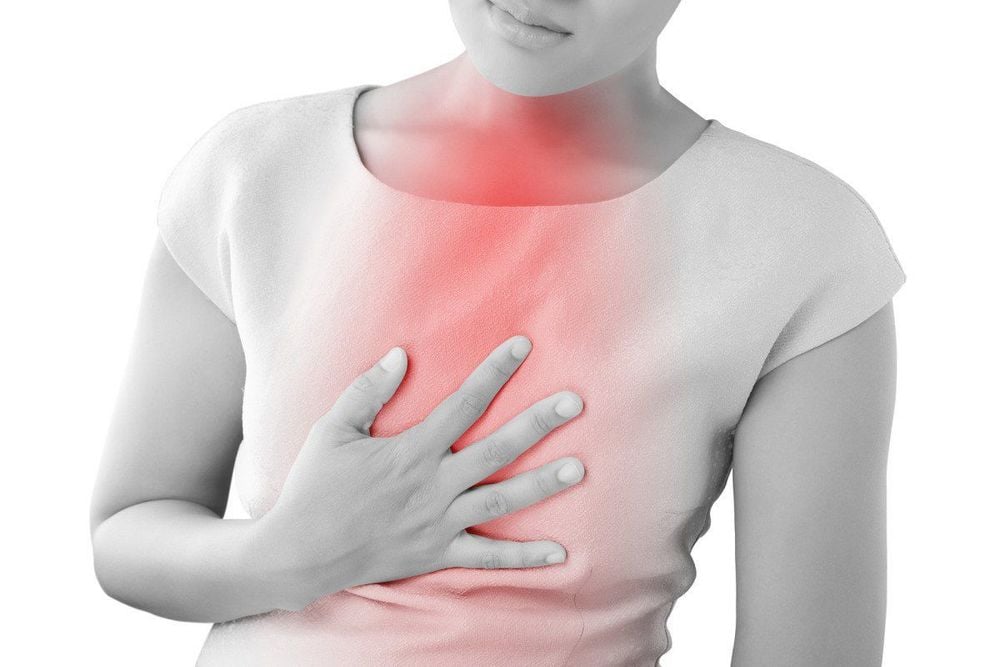
Đau tức ngực khi ăn và nuốt thức ăn có thể là dấu hiệu của ung thư thực quản.
To prevent esophageal cancer and limit chest pain when eating, you should stop drinking and smoking, avoid using canned food, limit the use of foods or drinks that are too hot, and hard foods. because it can damage the esophagus. Besides, should eat lots of green vegetables and drink enough water every day. For patients who have ever had gastroesophageal reflux disease, it is recommended to follow the doctor's treatment and perform periodic follow-up examinations.
3. What to do when having chest pain?
Chest pain is not uncommon for most people. So what should you do when you have chest pain? In case of severe or repeated chest pain, you should go to the medical center to be examined and diagnosed by a doctor, determine the cause of the disease, must be determined whether chest pain is caused by vascular disease. rim or not? , especially in elderly subjects, with co-morbidities such as hypertension, diabetes, dyslipidemia, atherosclerosis or respiratory diseases.After determining the exact cause of chest pain, the patient needs to follow the treatment according to the doctor's instructions. In case of heart-related angina (coronary artery disease, myocardial infarction, aortic dissection) need to be very cautious, follow a healthy lifestyle and proper nutrition as advised. of a specialist doctor.
It is best when having chest pain, you need to immediately stop working to rest, do not work hard, do not exert yourself. The exercise regime also contributes significantly to the treatment of chest pain. Patients should build a habit of exercising and moving their body daily with gentle movements, limiting heavy sports such as badminton, table tennis, weightlifting, ... because it can cause chest pain worsens.

Bên cạnh đó, trang thiết bị hiện đại và đội ngũ Y bác sĩ nhiều năm kinh nghiệm cũng là yếu tố quyết định khả năng sống còn của bệnh nhân.
Together with Vinmec protect you and your family against diseases related to chest pain.
Please dial HOTLINE for more information or register for an appointment HERE. Download MyVinmec app to make appointments faster and to manage your bookings easily.





